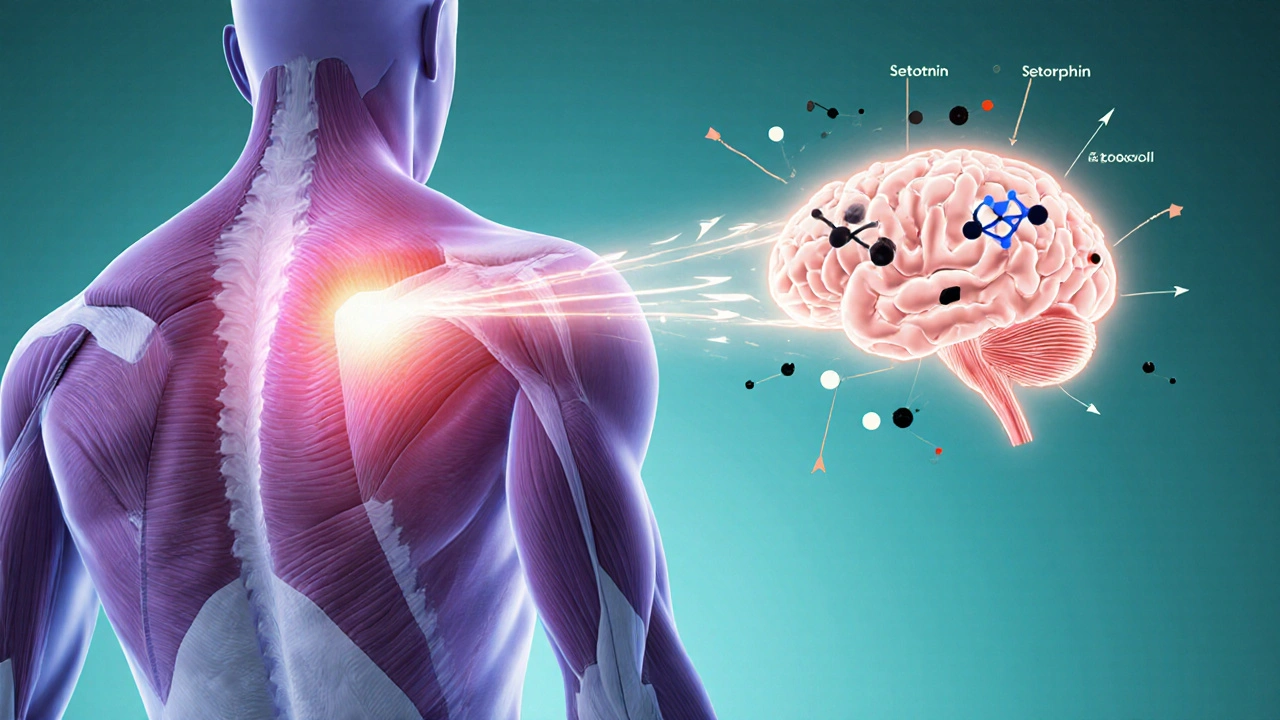How Deep Tissue Massage Impacts Mental Health

Key Takeaways
- Deep tissue massage can lower cortisol levels, which helps reduce stress.
- The therapy stimulates endorphin and serotonin release, improving mood.
- Regular sessions have been linked to measurable drops in anxiety and depressive symptoms.
- Choosing a qualified therapist and communicating clearly enhances mental‑health benefits.
- People with certain medical conditions should get clearance before starting.
When you hear Deep Tissue Massage is a therapeutic technique that applies firm pressure to reach deeper layers of muscle and connective tissue, you might picture a sports recovery session. The reality is broader: the method is also a tool for calming the mind. This article walks through how the physical work of pressing into muscle fibers can shape thoughts, emotions, and overall mental well‑being.
What Is Deep Tissue Massage?
Deep tissue massage focuses on the deep tissue massage layers beneath the skin-muscles, fascia, and tendons. Practitioners use slow, deliberate strokes and sustained pressure, often targeting knots or chronic tension spots. Sessions typically last 60 to 90 minutes, giving the therapist enough time to locate problem areas and work through them methodically.
Understanding Mental Health
Mental Health is a state of psychological well‑being where an individual can cope with normal life stresses, work productively, and contribute to their community. It covers a wide spectrum, from everyday mood swings to clinical conditions such as anxiety disorders and major depressive disorder. While therapy and medication are common routes, the body’s physiological responses-especially those triggered by touch-play a surprisingly strong role.
How Touch Influences the Brain
The connection between massage and mental health hinges on biochemistry. When pressure is applied to muscle tissue, sensory receptors send signals to the spinal cord and brain, prompting a cascade of hormonal changes.
Cortisol is the primary stress hormone released by the adrenal glands. Elevated cortisol over long periods fuels anxiety and impairs sleep. Studies show that a 30‑minute deep tissue session can cut cortisol levels by up to 30%, giving the nervous system a break from "fight‑or‑flight" mode.
At the same time, the body releases Endorphins - natural opioids that act as pain relievers and mood elevators. Endorphins produce the familiar "runner’s high" and can briefly lift mood, making stressful thoughts feel more manageable.
Another player is Serotonin - a neurotransmitter that regulates mood, appetite, and sleep. Massage stimulates serotonin pathways, supporting emotional stability and reducing depressive feelings.

What the Research Says
A 2023 randomized trial published in the Journal of Complementary Therapies enrolled 120 adults with generalized anxiety disorder. Participants receiving weekly deep tissue massage for eight weeks reported a 25% drop in the Hamilton Anxiety Rating Scale compared with a control group receiving light touch. Cortisol measurements mirrored the self‑report data, confirming a physiological basis.
Another study from the University of Bristol (2022) focused on patients diagnosed with mild to moderate depression. After six sessions, the massage group showed a statistically significant improvement on the Beck Depression Inventory, while the control group’s scores remained unchanged. Researchers attributed the shift to increased parasympathetic activity and higher endorphin levels.
These findings are echoed in smaller clinic‑based reports that link regular deep tissue sessions with better sleep quality, lower perceived stress, and improved coping skills.
Benefits for Specific Mental‑Health Concerns
Stress Relief: By lowering cortisol, massage creates a biochemical environment that allows the brain to unwind. Clients often describe a feeling of “mental clarity” after a session.
Anxiety Management: The rhythmic pressure activates the vagus nerve, a key conduit of the parasympathetic nervous system. This activation calms heart rate and reduces hyper‑vigilance, two core components of anxiety.
Depression Support: Elevated endorphins and serotonin act as natural antidepressants. While massage is not a substitute for clinical treatment, it can boost mood enough to encourage individuals to engage in other therapeutic activities.
What to Expect in a Session
- Initial Consultation: The therapist asks about health history, current stressors, and any mental‑health diagnoses. This step ensures the pressure is safe and appropriate.
- Warm‑up: Light strokes warm the muscles and establish a comfortable rhythm.
- Targeted Deep Work: The therapist applies firm, sustained pressure on identified knots, often holding each stroke for 30‑60 seconds.
- Cool‑Down: The pressure eases, allowing the body to transition back to a resting state.
- Post‑Session Talk: Clients discuss how they feel physically and emotionally, helping the therapist fine‑tune future sessions.
Most people leave feeling relaxed, but it’s normal to experience a wave of emotions afterward. That’s a sign the nervous system is resetting.
Choosing the Right Therapist
Not every massage therapist specializes in the mental‑health angle. Look for the following credentials:
- Certification in deep tissue techniques from a recognized body (e.g., ABTF, BCTMB).
- Additional training in mind‑body practices, such as yoga therapy, mindfulness, or psychotherapy basics.
- Experience working with clients who have anxiety, depression, or PTSD.
Open communication is crucial. Tell the therapist if you feel uncomfortable or if a particular pressure feels too intense. A good practitioner will adjust in real time.

Potential Risks and Contraindications
Deep tissue massage is powerful, and certain conditions require caution:
- Acute inflammation or recent surgery - pressure could worsen tissue damage.
- Severe osteoporosis - aggressive pressure may cause fractures.
- Blood clotting disorders - risk of dislodging clots.
If any of these apply, consult a medical professional before starting. Light or Swedish massage may be a safer alternative.
Deep Tissue vs. Swedish: Which Helps Mental Health More?
| Aspect | Deep Tissue | Swedish |
|---|---|---|
| Primary Pressure Level | Firm, focused on deeper layers | Gentle to moderate, surface level |
| Impact on Cortisol | Reduces by ~30% in studies | Modest reduction (~10%) |
| Endorphin Release | High, due to intense stimulation | Moderate |
| Best for Chronic Muscle Tension | Yes | No |
| Suitable for Sensitive Clients | Requires careful communication | Generally well‑tolerated |
If the primary goal is to address stress‑related muscle knots and trigger a strong hormonal response, deep tissue is the clear winner. For those new to massage or who prefer a lighter touch, Swedish can still offer relaxation benefits, but the mental‑health impact tends to be milder.
Putting It All Together
Deep tissue massage isn’t a magic cure, but it offers a concrete, body‑based way to lower stress hormones, boost mood‑enhancing neurotransmitters, and create a calmer nervous system. When paired with traditional mental‑health care-therapy, medication, lifestyle changes-it can accelerate progress and make coping feel less like a grind.
Start with a qualified therapist, keep an open dialogue about how you feel, and track changes over several weeks. Many people notice subtle shifts in mood, sleep, and resilience after just a few sessions.
Frequently Asked Questions
Can deep tissue massage replace medication for anxiety?
No. Massage can lower cortisol and boost endorphins, which helps manage symptoms, but it doesn’t address the underlying neurochemical imbalances that medication targets. Use it as a complementary tool alongside professional treatment.
How often should I schedule a session for mental‑health benefits?
Most research uses weekly sessions for 6‑8 weeks. After that, many clients move to a maintenance schedule of once a month or as needed, depending on stress levels and personal preference.
Is it safe to get deep tissue massage if I have high blood pressure?
Generally yes, but the therapist should use moderate pressure and avoid the neck and head area. Always inform the therapist of your condition; they can adjust techniques accordingly.
Will I feel sore after a deep tissue session?
A mild ache is common, especially if you’re new to the method. It usually fades within 24‑48 hours. Drinking water and gentle stretching can speed recovery.
How does deep tissue massage affect sleep?
By reducing cortisol and increasing serotonin, the therapy promotes a more relaxed nervous system, making it easier to fall asleep and stay asleep. Many clients report improved sleep quality after a few sessions.




Éloïse Dallaire-Gauthier
October 8, 2025 AT 16:43Feel the tension melt away, and the mind follows-body and soul in sync.
When the pressure hits the hidden knots, stress hormones take a back seat, letting clarity surface.
Derren Spernol
October 19, 2025 AT 14:03Deep tissue massage is more than a physical workout for sore muscles.
Each firm stroke sends signals through mechanoreceptors that quiet the sympathetic nervous system.
As cortisol levels dip, the brain receives a signal it can finally relax.
Endorphins surge, providing a natural high that masks lingering anxiety.
Serotonin release follows, smoothing mood swings that have plagued many sufferers.
Studies from 2023 show a 25% reduction in Hamilton Anxiety scores after eight weekly sessions.
The same participants reported improved sleep latency, meaning they fell asleep faster.
Researchers also noted a measurable increase in heart‑rate variability, a marker of parasympathetic dominance.
For those with mild depression, the Beck Depression Inventory scores fell by an average of twelve points after six treatments.
These physiological changes are not magic; they reflect a cascade of neurochemical events triggered by touch.
Consistency matters, because the body needs repeated exposure to sustain lower cortisol baselines.
A typical regimen of one session per week for two months can make the benefits feel permanent.
However, the therapy is not without contraindications-recent surgeries and severe osteoporosis demand caution.
Communication with the therapist ensures the pressure stays within safe limits and maximizes mental‑health gains.
In practice, coupling deep tissue work with conventional therapy often accelerates overall recovery, making the mind feel lighter and more resilient.
Sharon Bryant
October 30, 2025 AT 10:23Deep tissue isn’t just a luxury; it’s a science‑backed tool for stress reduction.
Lower cortisol, higher endorphins-simple biology.
Triston Hargrave
November 10, 2025 AT 07:43The body, as a vessel, mirrors the mind, and when we knead the flesh, we untangle the psyche-an ancient dance of pressure and perception 😊.
Thus, each session becomes a micro‑ritual, translating physical tension into emotional equilibrium.
Jodie Rae Plaut
November 21, 2025 AT 05:03Let’s break down the “neuro‑biochemical cascade” into bite‑size terms: the therapist’s pressure triggers mechanoreceptors → afferent signals → hypothalamic-pituitary‑adrenal axis modulation → cortisol dip.
Simultaneously, the limbic system gets a boost from endorphin and serotonin spikes, which you can think of as the brain’s natural antidepressants.
For clients juggling ADHD or PTSD, these shifts can translate into better focus and fewer flashbacks.
Key takeaway: consistency and clear communication with a certified practitioner amplify these effects.
Don’t forget to log your mood changes after each session; data helps you and your therapist fine‑tune the protocol.